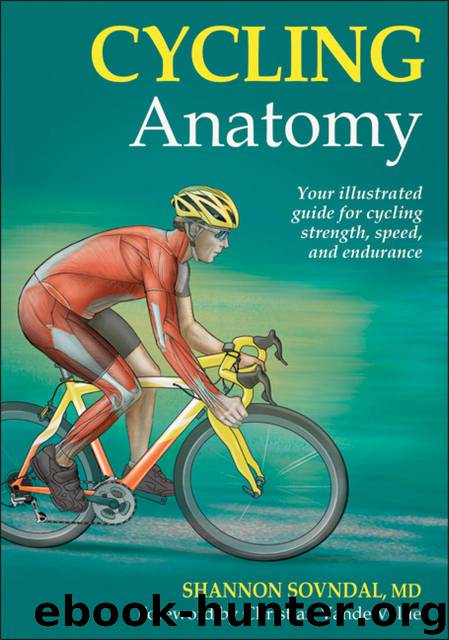Cycling Anatomy by Shannon Sovndal

Author:Shannon Sovndal
Language: eng
Format: mobi, epub
Publisher: Human Kinetics
Published: 0101-01-01T00:00:00+00:00
Figure 5.1 The spine.
Intervertebral discs cushion the intersection between two vertebrae and allow smooth movement of the spine. The fibrous outer section of the disc is called the annulus fibrosus. The inner section, which helps distribute pressure and stress, is called the nucleus pulposus. A herniated disc occurs when there is a breakdown of the fibrous outer band and a bulging out of the nucleus pulposus. This bulge can happen anywhere around the disc, but when it happens near the vertebral foramen, it can compress the exiting nerve and cause excruciating pain and weakness.
Cyclists have a tendency to develop back problems because the riding position places anatomical stressors on the curved spine. Normally, the lower back has a lordotic curve that causes the lumbar spine to appear to bend inward. When you ride your bike, this curve is flattened. Cyclists like to ride with a “flat back” because it improves aerodynamics. However, the flattening of your lordotic curve can place increased pressure on the anterior aspect of your lumbar vertebrae and intervertebral discs. If the force becomes too great, disc herniation can result. By easing into your training and working the muscles of your back and abdomen in the gym, you can alleviate many of the problems that may arise from your cycling position.
Download
This site does not store any files on its server. We only index and link to content provided by other sites. Please contact the content providers to delete copyright contents if any and email us, we'll remove relevant links or contents immediately.
| Bike Repair | Excursion Guides |
| Mountain Biking |
Shoe Dog by Phil Knight(5147)
The Rules Do Not Apply by Ariel Levy(4866)
Walking by Henry David Thoreau(3897)
How to Read Water: Clues and Patterns from Puddles to the Sea (Natural Navigation) by Tristan Gooley(3410)
Running Barefoot by Amy Harmon(3398)
I'll Give You the Sun by Jandy Nelson(3362)
Crazy Is My Superpower by A.J. Mendez Brooks(3332)
How to Read Nature by Tristan Gooley(3251)
How Music Works by David Byrne(3191)
The Boy, the Mole, the Fox and the Horse by Charlie Mackesy(3001)
The Fight by Norman Mailer(2849)
Seducing Cinderella by Gina L. Maxwell(2604)
Cuba by Lonely Planet(2579)
Accepted by Pat Patterson(2307)
Going Long by Editors of Runner's World(2298)
The Unfettered Mind: Writings from a Zen Master to a Master Swordsman by Takuan Soho(2249)
The Happy Runner by David Roche(2194)
Backpacker the Complete Guide to Backpacking by Backpacker Magazine(2193)
Trail Magic by Trevelyan Quest Edwards & Hazel Edwards(2127)
